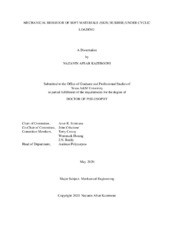| dc.description.abstract | In this study, we carry out a combination of experimental investigation and modeling of the mechanical behavior of soft materials, such as rubber and skin. Typically, such materials have been modeled as being purely hyperelastic, and there is an extensive literature in this regard. However it has been well known that they show strong hysteresis which is revealed upon unloading. While this effect has been studied extensively in rubber, it is only recently that some attempts have been made to study skin–that two mostly as viscoelastic materials and it is recoverable. However, skin is not completely recoverable and it needs to be considered as an inelastic material. In this work, Mullins type softening is studied on skin under uniaxial cyclic loading. The effect of strain rates and fiber orientations are investigated on Mullins type softening and indicated that the extent of softening is more significant for higher strain rates and it is different for different orientations. Also, a substantial hysteresis persists even at very low strain rates indicating inelastic behavior beyond the rate sensitive viscoelastic response and shows irreversible changes in fiber orientation, and it is in contrast to rubber that is recoverable. A simple microstructurally motivated inelastic 1-D model is developed for this uniaxial response of skin, that includes nonlinear elastic response and a strong strain dependent hysteresis, and it is shown that it can model the comprehensive response of skin under cyclic loading. Later, to overcome the restriction of 1-D model, a Green-elastic response function based on a non-algebraic invariant representation for the in-plane deformation of skin is developed for the stabilized response of the skin. This model is developed by using a recently developed QR decomposition of the deformation gradient using the orthotropy axes and defining physically meaningful ’one equivalent strain’. Since skin is an orthotropic material, it is helpful to study skin behavior under biaxial testing; a custom biaxial setup was built to study skin behavior under biaxial testing. Fiber orientations of undeformed and deformed samples are studied by histology. Fiber distribution shows that before deformation, fibers are randomly oriented, and after deformation, fibers were mostly oriented in the loading direction and have permanent deformations, especially after uniaxial testing.
Due to the inaccuracy of specimen geometry and imprecision in experiments, especially for soft tissues, inferring material parameters has always been a challenge. Rather than trying to obtain homogeneous deformation conditions, a new technique based on the virtual fields method and Holzapfel model with three invariants and five constants is used to extract the material properties. Despite significant inhomogeneity in the deformation and errors and missing data in the measured displacement field, the material parameters were obtained, and the proper match between the internal virtual work and external virtual work indicates a good identification with the virtual field method. | en |


